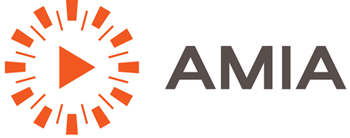Program Stream: Library Science Meets Rocket Science
Library Science Meets Rocket Science
Emerging technologies pose exciting new benefits while also posing new challenges. Machine learning and cloud storage are two such technologies shaping the efforts of archivists in our community today. This stream from submitted proposals is an opportunity to learn, explore, and discuss Digital Asset Management when “Library Science meets Rocket Science”.

11:00am – 12:00pm
LSRS: How to Preserve in the Cloud
Andrea Kalas, Paramount Pictures
Andrea Kalas, long time AMIA member, discusses one of the areas of intense technical development and implementation: The Cloud and what it means to the longevity of audiovisual art, culture and history. The Cloud promises and can deliver, through virtually infinite processing, magic solutions to some very real problems: pattern recognition trained on specific data sets can add incremental search terms with incredible speeds; sharing of large data sets around the world means more inclusion. The Cloud remains quite unknowable at this point in time too, and that’s something Andrea and a group of others took on recently. She’ll discuss the outcome of this work from the Entertainment Technology Council and share a white paper called Guidelines for Preservation of Moving Images in the Cloud.
2:00pm – 3:00pm
Intelligent Content Discovery for Media Archives: AI and Machine Learning
Buzz Hays, Google
Metadata extraction from media archives is becoming more challenging as archives grow in size. This presentation will focus on practical uses of AI/ML tools for mining meaningful metadata from visual and audio content to better inform content curators and archivists. An overview of the tools available on Google Cloud will be discussed (Intelligent Content Discovery: Speech-to-Text, Visual Intelligence, Logo Detection, Explicit Content Detection, Sentiment Analysis), followed by a demonstration of Iron Mountain’s InSight media asset management tool to demonstrate the visualization of media archive metadata along with a simple method of retraining machine learning models with no data science or ML experience.
3:30 PM – 4:30 PM
Digital Asset Management in 2019: Trends in Stills Archiving (AI)
Dony West, Paramount Pictures
Caitlin Denny, Paramount Pictures
Rebecca Ruud, Paramount Pictures
Our first topic would discuss the pro’s and con’s of incorporating “computer learning” applications into our current preservation workflows for out stills collection at Paramount. A general overview of our current preservation methods, and newly integrated AI within our DAM. Production photography from lost silent stills. Our Sr Archivist in photochemical will discuss our collection of rare, silent stills within our collection. Discussing our search & discovery process, as well as preservation and digitization of this amazing photography. How a still illustrates a motion picture archive – Designs for home media, Costume exhibition, Internal Marketing, Licensing, Franchise Support, and Reference. Stills are often overlooked as a pivotal part of the film making process. We will discuss a bit of the historical and contemporary trends and use cases for these important assets, and how they are used in support beyond the marketing of a film.
4:45pm – 5:45pm
Creation of an Archival Moving Image Database for AI Research
Jim Lindner, Media Matters
David Weiss, Northeast Historic Film
Northeast Historic Film is embarking on a project to make archival film samples open and available to the scientific community for algorithmic finding aid research. We realize that for algorithms to be developed, appropriate sample materials must be available to the scientific community. Virtually no work has been done on algorithmic finding aides appropriate for legacy archival content. This is a huge problem. While Archives have embraced issues related to access, virtually no work has been done on non-textual finding aids. We realize that the expertise for this work does not lie in our field; rather it is in other communities that may not even be aware of the issues and differences of archival moving image content vs. contemporary content. Our intent is to provide different “seed” footage to a few repositories that represent different aspects of a very complex project.
